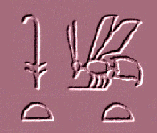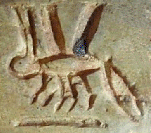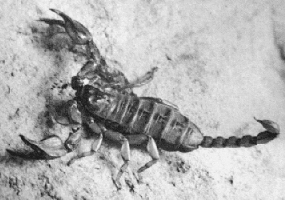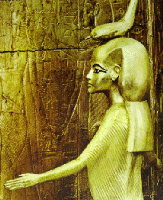
Consulting Entomologist

Tel/Fax: 01275 854224
E-Mail: [email protected]
Site Guide
Site Search
Home Page
Career Page
Insect Files
- Contents
- Bug Index
- The World of Bugs
- Classification of Bugs
- Insect Identification
- Insect Fossils
- Insect Body-parts
- Micro View of Bugs
- Insect Life Cycles
- Insect Defences
- Insects of Nailsea
- Pesticide Safety
- Bibliography
Shortcut to the main groups of insects and other arthropods...
Bug Rhymes & Poems
Links
Shop
Payments (credit/debit card)
Sacred Insects of Ancient Egypt |
Class: Insecta Order: (various) |
| Throughout their long history the ancient egyptians held certain insects in special reverence . . . . . . | |
as well as other related arthropods . . . . . . |
|
 scarab hieroglyph  flying-scarab hieroglyph MORE ON SCARABS EGYPTIAN CHRONOLOGY (quick reference) Predynastic 5500-3100 BC Early Dynastic Period 3100-2686 BC 1st Dynasty 3100-2890 BC 2nd Dynasty 2890-2686 BC Old Kingdom 2686-2181 BC 3rd Dynasty 2686-2613 BC 4th Dynasty 2613-2494 BC 5th Dynasty 2494-2345 BC 6th Dynasty 2345-2181 BC 1st Intermediate Period 2181-2055 BC (7-10th Dynasty) Middle Kingdom 2055-1650 BC (11-14th Dynasty) 2nd Intermediate Period 1650-1550 BC (15-17th Dynasty) New Kingdom 1550-1069 BC 18th Dynasty 1550-1295 BC 19th Dynasty 1295-1186 BC 20th Dynasty 1186-1069 BC 3rd Intermediate Period 1069-747 BC (21-24th Dynasty) Late Period 747-332 BC 25th Dynasty 747-656 BC 26th Dynasty 664-525 BC 27th Dynasty (1st Persian) 525-404 BC 28th Dynasty 404-399 BC 29th Dynasty 399-380 BC 30th Dynasty 380-343 BC 2nd Persian 343-332 BC Ptolemaic Period 332-30 BC Roman Period 30 BC - AD 395 from Shaw & Nicholson 1995 (dates are approximate) |
SCARAB (DUNG) BEETLEIt is generally accepted that the sacred scarab beetle of egyptian mythology originated from the species Scarabaeus sacer, although the ancient worship of this beetle was eventually extended to all members of the scarab or dung beetle family. The scarab was personified by Khepri, a sun-god associated with resurrection and new life. The ancient egyptians believed that the scarab beetle came into being of itself from a ball of dung (the idea of self-creation). It was worshipped under the name of Khepri, which means 'he who has come into being' or 'he who came forth from the earth'. The god Khepri was associated with the creator-god Atum and was regarded as a form of the sun-god Ra. Just as the beetle pushed its ball of dung over the ground, so Khepri in the form of a scarab beetle, it was thought, rolled the solar disc across the sky each day. 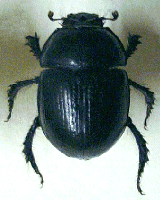 Typical scarab beetle (Geotrupes), similar to the sacred scarab (Scarabaeus) The scarab was a common type of amulet, seal or ring-bezel found in Egypt from the 6th Dynasty (c.2345 BC) until the Ptolemaic period (c.30 BC). The earliest were purely amuletic and uninscribed; it was only during the Middle Kingdom (2055-1650 BC) that they were used as seals. The flat underside of the scarab, carved in stone or moulded in faience (a type of glazed pottery) or glass, was usually decorated with designs or inscriptions, sometimes incorporating a royal name. 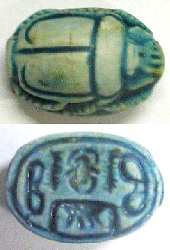
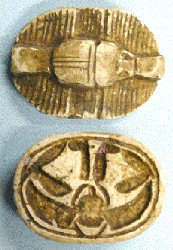 Two examples of scarab amulets or seals inscribed on the underside with hieroglyphs, including a scarab glyph (bottom left) and a flying-scarab glyph (bottom right). The scarab on the left (11 mm long) is from the Late Period (c.500 BC), whereas that on the right (25 mm long) is much older and from the reign of Rameses II (1279-1213 BC). Both these amulets are pierced longways to hang on a necklace, as typical of many scarab amulets. There were also a number of funerial types, such as the 'winged scarab' (nearly always made of blue faience and often incorporated into the bead net used to cover mummies), and the 'heart scarab' (sometimes inscribed with Chapter 13b of The Book of the Dead and usually placed on the chest of a mummified body under the cloth wrappings). These were included in burials from the 13th Dynasty (1795-1650 BC) onwards. 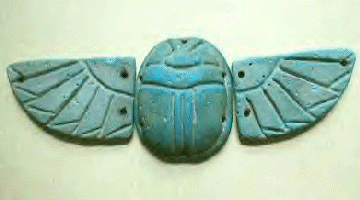
Two examples of funerial scarabs: 'winged scarab' (left) made of blue faience with pierced holes for attachment to the outer covering of a mummified body (age unknown, span 150 mm); 'heart scarab' (right) carved in stone, this example uninscribed and unpierced, and would be placed on the chest of a mummified body under its coverings (c.900 BC, 45 mm long). The term 'scaraboid' is often used to describe a seal or amulet which has the same ovoid shape as a scarab, but may have its back carved in a form other than that of a scarab beetle. The scarab and flying-scarab hieroglyphs were used in egyptian texts to represent the name of the creator-god, Khepri, and also to represent the word kheprer - meaning 'flying beetle' or 'sacred scarab' - and the word kheper - meaning 'become' or 'manifestation of '. The throne names (prenomens) of many pharaohs of the 18th Dynasty included the scarab (kheper) glyph as an element, such as those of Tuthmosis III (1483-1429 BC), Amenhotep II (1431-1405 BC), Tuthmosis IV (1405-1395 BC) and Tutankhamun (1338-1328 BC), as illustrated below. 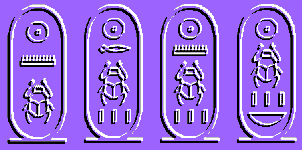 The prenomen cartouches of (left to right): Tuthmosis III (Men-kheper-Re), Amenhotep II (Aa-kheperu-Re), Tuthmosis IV (Men-kheperu-Re) and Tutankhamun (Neb-kheperu-Re), all of which include a scarab (kheper) glyph. These translate as: 'Established' (Men), 'Great' (Aa) or 'Lordly' (Neb) - 'manifestation of ' (kheper) or the plural form (indicated by three short lines) 'manifestations of ' (kheperu) - 'the sun god' (Re). | ||||
| <<< TOP
| |||||
|
(no hieroglyph) EGYPTIAN CHRONOLOGY (quick reference) |
BUPRESTID (JEWEL) BEETLEScarabs were not the only beetles to capture the imagination of the ancient egyptians. The buprestid or jewel beetle is another type frequently found in tombs and modelled as amulets for hanging on necklaces. The name 'jewel beetle' comes from the vivid metallic colouring of many species, displayed in subtle shades of bright irridescent greens, golds and purple-reds. Keimer (1938) suggested that the buprestid most likely depicted on artifacts by the ancient egyptians was a species called Steraspis squamosa, a large beetle about 35 mm long as an adult, with a wood-boring larval stage that feeds on the tamarisk tree. 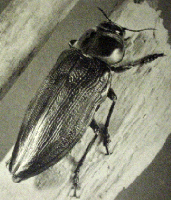 Typical buprestid beetle Although the symbolism of bupestid amulets and other artifacts remains obscure, Kritsky (1991) suggested a possible religious significance because the wood-boring habit of the beetles could be linked to the Osiris myth. According to this myth, Osiris (lord of the underworld and afterlife) was tricked by his brother Seth and became trapped inside a tamarisk tree, eventually to be released and brought back to life when the tree was split open by Isis. In much the same way, ancient egyptian carpenters may well have found buprestid beetles when they split logs and prepared boards for coffins, and so linked the emergence of these beetles from split logs to the myth. Thus, the buprestid amulets may have symbolised the rebirth of Osiris. Bupestrid amulets were made of several substances, including gold, calcite and faience (glazed pottery). A spectacular necklace trimmed with many golden buprestid beetle amulets, dating from the 6th Dynasty (2345-2181 BC), is on display at the Museum of Fine Arts in Boston USA. An unusual use of the buprestid beetle motif can be seen on the bed-canopy of Queen Hetepheres in the Egyptian Museum Cairo, where golden buprestids decorate the pin-heads holding together the corner posts of the bed-canopy. Queen Hetepheres was the wife of the 4th Dynasty pharaoh Sneferu (2613-2589 BC). | ||||
| <<< TOP
| |||||
|
(no hieroglyph) EGYPTIAN CHRONOLOGY (quick reference) |
ELATERID (CLICK) BEETLEA third type of beetle apparently of mythological significance to the ancient egyptians was the elaterid beetle, commonly called the click beetle. Of the elaterid beetles known from Egypt, Keimer (1938) considered Agrypnus notodonta as the most likely species represented in ancient carvings. 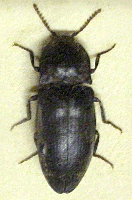 Typical elaterid beetle (Agrypnus) Ancient artifacts that appear to depict elaterid beetles include two carved reliefs from the 1st Dynasty (3100-2890 BC) and a necklace of golden click beetle amulets dating from the 4th Dynasty (2613-2494 BC). Of the three artifacts, Kritsky (1991) considered the carved reliefs best indicate the symbolic importance of the click beetle. The first is a triangular carving with two elaterids placed head to head and incorporated into the symbol of the goddess Neith. The second relief depicts part of an elaterid beetle holding the sacred sceptre of the gods, called the uas or waas sceptre. Thus, although their precise symbolism is unclear, elaterids possibly had some religious or protective significance. | ||||
| <<< TOP
| |||||
 bee hieroglyph EGYPTIAN CHRONOLOGY (quick reference) |
HONEY BEEAccording to one egyptian myth, honey bees (scientific name Apis mellifera) were the tears of the sun god Ra. Their religious significance extended to an association with the goddess Neith, whose temple in the delta town of Sais in Lower Egypt [map] was known as per-bit - meaning 'the house of the bee'. Honey was regarded as a symbol of resurrection and also thought to give potection against evil spirits. Small pottery flasks, which according to the hieratic inscriptions on the side originally contained honey, were found in the tomb of the boy-king, Tutankhamun. 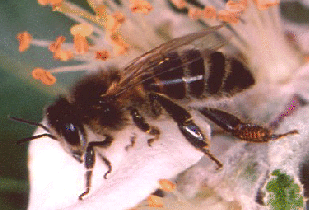 Honey bee (Apis mellifera) Throughout ancient egyptian history the bee has been strongly associated with royal titles. In Predynastic and early Dynastic times, before the union of Upper and Lower Egypt, the rulers of Lower Egypt used the title bit - meaning 'he of the bee', usually translated as 'King of Lower Egypt' or 'King of North', whereas the rulers of Upper Egypt were called nesw - meaning 'he of the sedge', translated as 'King of Upper Egypt' or 'King of the South'. In later times, after the union of Upper and Lower Egypt, the pharaoh rulers used the title nesw-bit - meaning 'he of the sedge and the bee', which is conventionally translated as 'King of Upper and Lower Egypt' or 'King of the South and North'.
Bee-keeping is depicted in egyptian temple reliefs as early as the 5th Dynasty (2445-2441 BC). These show that apiculture was well established in Egypt by the middle of the Old Kingdom. Records from at least one tomb workers' village during the New Kingdom (1550-1069 BC) indicate that the workmen there kept bees and this was doubtless true of other communities throughout egyptian history. Bee-keeping is also depicted in some 18th and 26th Dynasty tombs. Bees were certainly of great importance in providing honey, which was used both as the principal sweetener in the egyptian diet and as a base for medicinal ointments. The egyptians also collected beeswax for use as a mould-former in metal castings and also for use as a paint-varnish. The bee hieroglyph was used to represent the word bit - meaning 'bee' or 'honey', or the royal title 'King of Lower Egypt' or 'King of the North'. | ||||
| <<< TOP
| |||||
 fly hieroglyph EGYPTIAN CHRONOLOGY (quick reference) |
FLYIt is generally thought that the fly in egyptian mythology gave protection against disease or misfortune. Stone amulets in the form of flies were being made in Egypt as early as 3500 BC or thereabouts. In the Old and Middle Kingdom periods (2686-1650 BC), the fly was also depicted on various ritual artifacts, including the so called 'magic wands' often carved from hippopotamus ivory and probably intended to protect the owner from harm. 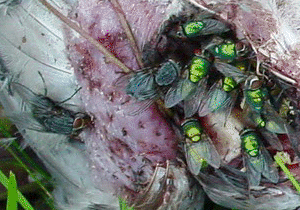 Typical flies (blow-flies and flesh-flies) attracted to carrion and meat; similar flies must have been very familiar to the ancient egyptians, much as they are commonly seen today around the food waste and household refuse of most human settlements Although the precise symbolism of early fly amulets remains obscure, their significance during the later New Kingdom period (1550-1069 BC) is better documented. At this time the military decoration known as the 'order of the golden fly' (or 'fly of valour') was introduced and awarded for bravery in battle. The fly was perhaps used in this way because of it's apparent qualities of persistence in the face of opposition. One of the best known examples is a gold chain with three pendants in the form of 'flies of valour' from the tomb of Queen Ahhotep I (c.1550 BC) and now in the Egyptian Museum Cairo. A fly amulet from the Late Period (c.250 BC). This example (29 mm long) is carved from pink agate and has a suspension loop at the top to hang on a necklace. The fly hieroglyph was used to represent the word aff - meaning 'a fly' - or in later times (c.1550 BC onwards) as a symbol of bravery. | ||||
| <<< TOP
| |||||
|
(no hieroglyph) EGYPTIAN CHRONOLOGY (quick reference) |
BUTTERFLYThe butterfly is thought to be an example of the ancient egyptian use of an insect motif purely for its own beauty rather than as a symbol of religious or mythological significance. Butterflies were often depicted in tomb paintings of river-bank scenes throughout the Old and New Kingdom periods (2686-1069 BC). Some of these reliefs and paintings show great attention to detail so that particular species of butterflies still represented in the present-day fauna of the region can be easily recognised. The species most often depicted on these ancient reliefs is a large and impressive butterfly called Danaus chrysippus, which is a close relative and very similar in appearance to the familiar monarch or milkweed butterfly (Danaus plexippus) of North America (occasionally also found in parts of northern Africa and Europe). 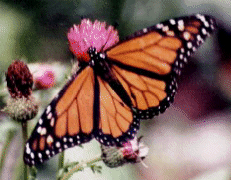 Monarch butterfly (Danaus plexippus) The butterfly motif was also used in jewelry design, such as found on several 4th Dynasty bracelets recovered from the tomb of Queen Hetepheres and now in the Museum of Fine Arts Boston USA. In addition, several amuletic artifacts resembling butterflies have been found in excavations at the royal necropolis and pyramid complex at Lisht on the banks of the Nile about 50 km south of Cairo [map], although these are so stylised that their identification as butterflies is open to question. | ||||
| <<< TOP
| |||||
 locust or grasshopper hieroglyph EGYPTIAN CHRONOLOGY (quick reference) |
LOCUST (GRASSHOPPER)The particular grasshopper species used as a motif by the ancient egyptians was probably the locust, either the desert locust (Schistocera gregaria) or the migratory locust (Schistocerca migratoria), both of which were probably common sights in the rich agricultural land bordering the Nile. Sudden plagues of these insects in ancient times no doubt caused much destruction of grain and other food crops, just as they do today. Desert locust (Schistocerca) at the 'hopper' stage without fully formed wings Most of the locust (or grasshopper) amulets and seals so far discovered are similar to those depicting scarab beetles, with a flat base usually inscribed and pierced through for threading on string or wire so that they could be worn. Possibly these amulets were thought to ward-off locust plagues. Locusts (or grasshoppers) were also depicted in tomb reliefs and paintings, as elements of wildlife along the Nile. The locust or grasshopper hieroglyph quite simply refers to the insect itself, although in certain contexts it appears to mean 'great numbers of individuals', for example on a wall in the temple at Medinet Habu near modern-day Luxor [map] there is an inscription which reads: 'battalions will come like the locusts'. The locust (or grasshopper) appears in hieroglyphic texts, for example, as a determinative to the word snehem - meaning 'locust' or 'grasshopper' - as illustrated below (a determinative symbol in hieroglyphic text, the locust or grasshopper symbol in this case, is not transliterated and merely indicates the meaning or context of the word represented by the preceding hieroglyphs). 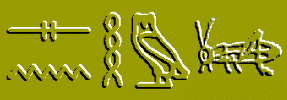 The hieroglyph inscription snehem (reading the symbols top to bottom and left to right, ignoring the determinative locust: s-n-eh-em) | ||||
| <<< TOP
| |||||
 scorpion hieroglyph EGYPTIAN CHRONOLOGY (quick reference) |
SCORPIONAlthough not an insect, this arachnid deserves mention because, like the serpent, it became the object of many cults and spells from the earliest times in egyptian history, doubtless due to the fear of its sting. Two types of scorpions are found in Egypt: the paler, more poisonous members of the family Buthridae and the darker, usually less harmful members of the family Scorpionidae.
The scorpion ideogram, one of the earliest known hieroglyphic signs, was depicted on wooden and ivory labels found in the late-Predynastic and Early Dynastic royal cemetery at Abydos [map] and also among the cache of cult equipment in the Early Dynastic temple at Hierakonpolis [map]. The goddess Serket was the principal divine personification of the scorpion and was usually depicted with a scorpion perched on her head (see picture above). Her name (also rendered as Serqit, Serquit, Selket or Selkis) is an abbreviation of the phrase Serket-hetyt (or Serqit-hetu) meaning 'she who causes the throat to breathe'. She was one of the four protector goddesses of coffins and conopic jars, together with Isis, Neith and Nephthys - the four godesses were often represented on canopic chests. Isis was also said to have been protected from her enemies by seven scorpions. Another, less well-known deity, the god Shed (also described as 'the saviour'), was linked with the scorpion and thought to give protection against its sting. One of the predynastic pharaoh kings of Upper Egypt (c.3150 BC) has been given the name Scorpion (also named Zekhen in some lists). He was identified from a ceremonial mace-head found at Hierakonpolis (modern-day Kom el-Ahmar, about 80 km south of Luxor) [map] which depicts a king wearing the white crown of Upper Egypt with the glyph of a scorpion next to his face. He appears to have been a warrior-king involved in the early struggles to unite Upper and Lower Egypt. From the Late Period (c.750 BC) onwards, images of scorpions were also depicted on so called cippi, which were types of amulets or stele used to ward off, and provide healing powers against, scorpion stings and snake bites. The scorpion hieroglyph was symbolic of the scorpion itself, and of the goddess Serket and the pre-dynastic king Scorpion. It was also used in hieroglyphic texts, for example, as a determinative to the word serk - meaning 'scorpion' and also 'to breathe' or 'to sniff the wind' - as illustrated below (a determinative symbol in hieroglyphic text, the scorpion symbol in this case, is not transliterated and merely indicates the meaning or context of the word represented by the preceding hieroglyphs).  The hieroglyph inscription serk (reading the symbols top to bottom, ignoring the determinative scorpion: s-er-k) | ||||
| <<< TOP
| |||||
 centipede hieroglyph EGYPTIAN CHRONOLOGY (quick reference) |
CENTIPEDEAgain not an insect, but belonging to the related Chilopoda, the centipede was revered by the ancient egyptians and is mentioned in the Pyramid Texts: 'The serpent is in the sky, the centipede of Horus is on earth'. 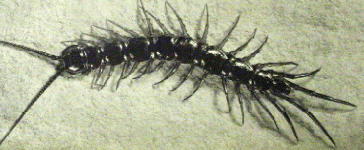 Typical centipede (Chilopoda) The minor god Sepa, whose name means 'centipede', was worshipped in Heliopolis [map], and was evoked as a charm against noxious animals and enemies of the gods. Sepa was also equated with Osiris as a mortuary god. | ||||
| <<< TOP
| |||||
|
References & further reading | |||||
|
LINKS TO ALL INSECT ORDERS <<< HERE >>> |
| <<< TOP | (use the back button on your web browser to return to the previous page) | TOP >>> |
